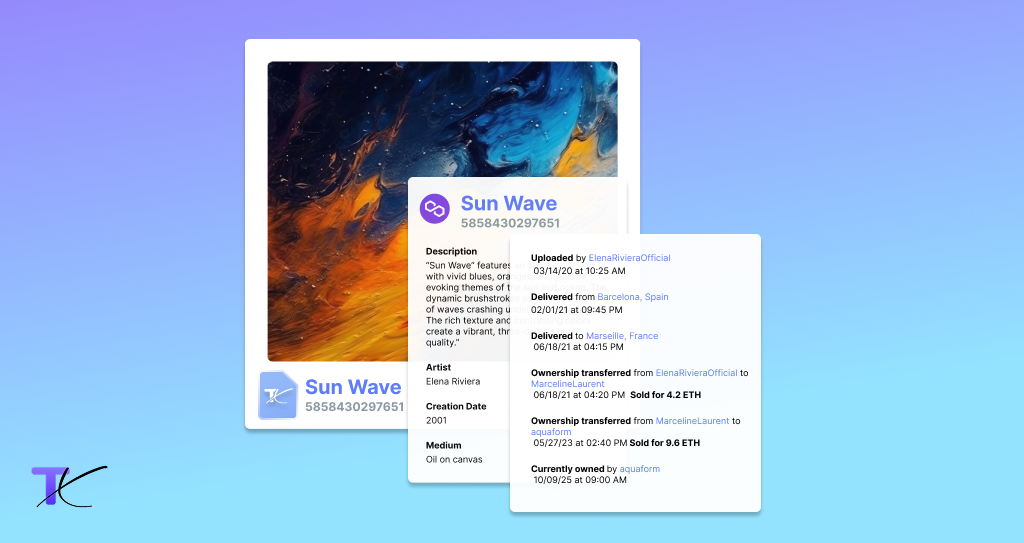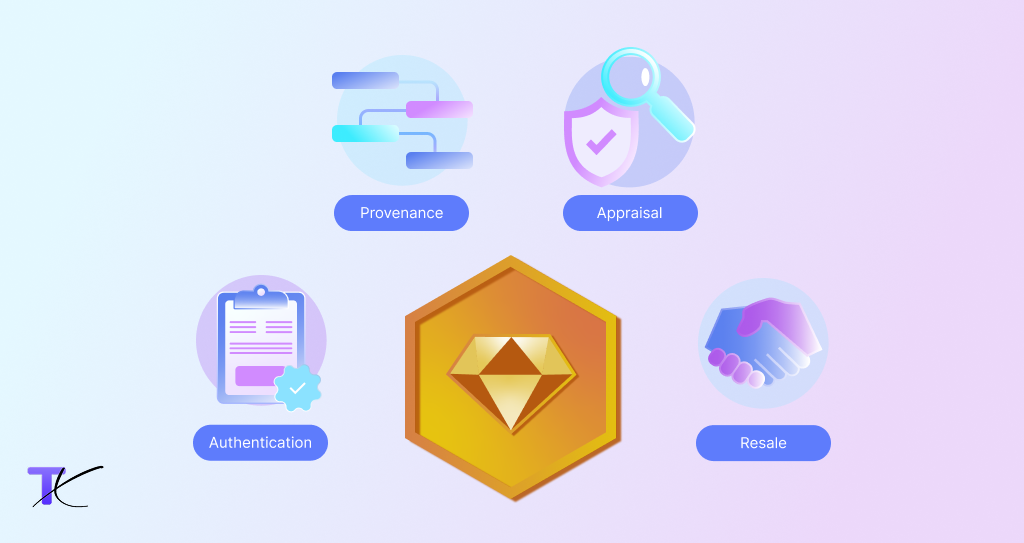For centuries, the value of fine art has rested on trust. A painting’s worth isn’t just in the paint and canvas — it’s in the story behind it: who created it, who owned it, and how its journey has been recorded. Yet trust in the art world has always been fragile. Forged works slip into the market, provenance records go missing, and ownership disputes drag on for years. According to INTERPOL’s Stolen Works of Art Database, nearly 57,000 stolen or missing works are actively listed, underscoring the scale of the challenge.
Now, blockchain is stepping in to change that. By creating an immutable digital ledger for art, TokenX‘s blockchain solutions are giving collectors, galleries, and artists a way to prove authenticity, protect value, and even open up new opportunities for how art is bought, sold, and shared. Through tokenization, real-world assets (RWAs) such as fine art can be represented as secure digital tokens on a blockchain, making provenance transparent, ownership verifiable, and assets far more liquid.
TL;DR Summary
- The art world struggles with forgeries, missing provenance, and complex ownership disputes — issues that reduce trust and liquidity.
- Blockchain provenance creates tamper-proof ownership records, simplifies transactions, and opens new possibilities like fractional ownership and digital twins.
- TokenX delivers enterprise-grade tokenization for art, providing secure provenance, compliance readiness, and scalable infrastructure.
👉 Want to see how provenance can work for your collection or institution? Contact us.
Pain Points in Fine Art Authentication and Provenance
| Pain Points in Fine Art Authentication and Provenance | How Blockchain + TokenX Solves It |
|---|---|
| 🎭 Counterfeit Artworks Forgeries and fake documentation erode trust, and fragmented databases make verification difficult. The Art Loss Register and the Getty Provenance Index show how critical provenance research is, yet records often remain fragmented. | Immutable Provenance Records Each artwork is linked to a unique blockchain token with full ownership history, eliminating the risk of forged documentation. |
| 🕵️ Lack of Transparent Provenance Missing or incomplete records lower credibility and market value. | Easy Verification Digital certificates tied to blockchain make authenticity verifiable in real time, without costly expert intervention. |
| 🤝 Loss of Trust Fraud and disputed ownership reduce buyer confidence and liquidity. | Increased Trust & Market Confidence According to the Deloitte–ArtTactic Art & Finance Report 2023, transparency and risk management are the top drivers of confidence. Blockchain addresses both, boosting trust and market liquidity. |
| 📑 Complex Transactions Art deals often involve multiple parties—dealers, galleries, auction houses, and collectors. Multiple intermediaries increase errors, fraud risk, and inefficiency. | Simplified Transactions Automated, transparent blockchain records streamline ownership transfers and reduce paperwork errors. |
| 💸 Insurance & Valuation Issues Without verified provenance, artworks are difficult to insure or appraise. | Accurate Insurance & Appraisals Immutable records give insurers and appraisers reliable data for fair valuation and coverage. |
Leading galleries and auction houses are already beginning to integrate blockchain into their processes, signaling mainstream momentum. As adoption grows, collectors can expect a more secure and transparent market backed by trusted institutions.
Have questions about tokenization?
Our team helps enterprises, galleries, and innovators bring real-world assets on-chain with security and transparency. Contact us to explore how TokenX can support your next initiative.
Contact Us
New Possibilities for Collectors
Blockchain doesn’t just solve problems — it unlocks new models for how art can be collected and experienced.
- Fractional Ownership – Instead of one person holding a $50M masterpiece, hundreds of collectors can each own a share. This makes blue-chip art more accessible — and far more liquid.
- Royalties for Collectors – Blockchain doesn’t just reward artists. With fractionalized works, collectors themselves can also earn royalties when their shares are resold or traded. This shared value model transforms fine art into a more participatory asset class, where both creators and collectors benefit financially from market activity.
- Digital Twins and Editions – Verified digital versions of physical works can circulate alongside originals, enabling limited digital editions and global exhibitions without moving fragile art.
- Global Accessibility – Collectors anywhere in the world can invest in, trade, or display pieces with confidence, expanding the market beyond elite circles.
- Enhanced Collector Experience – Beyond security and access, blockchain makes art collecting more interactive. Collectors can engage with digital twins, unlock exclusive limited-edition releases, and participate in global exhibitions without leaving home. This elevates collecting from passive ownership to an active, connected experience.
Picture this: A collector in Paris buys a fractional share of a Picasso stored in New York. The artist’s estate automatically receives royalties. The collector can later sell their share on a secondary marketplace, verified instantly, without moving the original painting. Meanwhile, the Picasso itself tours a global museum exhibition, with digital proof of ownership following it wherever it goes.
That’s the future TokenX is building: a more open, trusted, and dynamic art market.

Why TokenX
We’ve built our platform to make fine art verifiable by default:
- Secure provenance records with metadata tailored to art.
- NFC, RFID, and QR physical tags — see our work with luxury goods.
- Fractionalization options through ERC-1155 standards.
- Compliance-ready architecture, trusted custody, and enterprise-grade infrastructure.

Whether you’re a gallery, a museum, an insurer, or a collector, TokenX is your partner in bringing fine art into the blockchain era.
The art world has always been built on trust — but trust has always been fragile. Blockchain strengthens it. Collectors gain peace of mind. Artists gain royalties. Galleries and insurers gain efficiency and credibility. And the market as a whole becomes more transparent, accessible, and liquid.
By utilizing blockchain technology, TokenX provides artists, collectors, galleries, auction houses, and insurers with a secure, transparent, and tamper-proof solution for tracking art ownership and authenticity. As the art world continues to evolve, blockchain-powered provenance is set to become a cornerstone of trust, security, and efficiency in the art market.
👉 Ready to explore how blockchain can protect and grow your art collection? Contact the TokenX team
FAQs
1. What does “provenance” mean in the art world?
Provenance is the documented history of an artwork — who created it, who has owned it, and how it has been transferred over time. Strong provenance is essential for authenticity, valuation, and insurability.
2. Why is provenance in the art world such a challenge today?
Many artworks have incomplete or missing records, and forged documents are common. According to INTERPOL, tens of thousands of stolen or missing works circulate in the market, eroding trust and liquidity.
3. How does blockchain improve art authentication?
Blockchain creates an immutable ledger that records each artwork’s authenticity and ownership history. Once a piece is verified, its provenance can be tracked transparently, reducing the risks of forgery and disputed ownership.
4. Does blockchain replace expert authentication?
No — expert authentication is still critical to validate a work’s origin. Blockchain complements that process by ensuring the verified record can’t be altered, lost, or forged.
5. Can artworks be fractionalized with blockchain?
Yes. Using token standards like ERC-1155, ownership of high-value artworks can be split into multiple shares. This makes blue-chip art more accessible and tradable across global markets.


